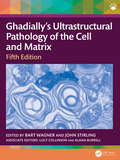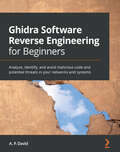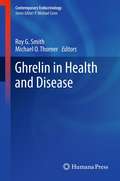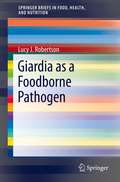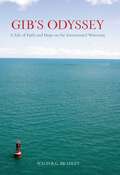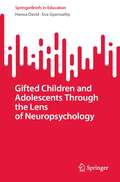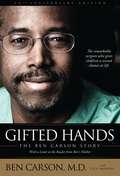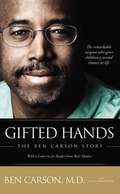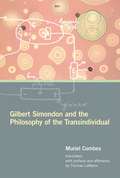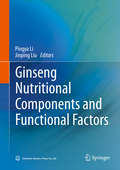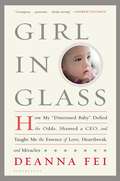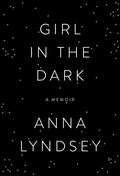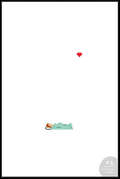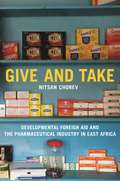- Table View
- List View
Gezonde en zieke mensen.
by J. De JongeIn dit boek wordt ingegaan op gezond functioneren en op ziek-zijn. Aspecten van gezondheidskunde, ziektekunde en anatomie-fysiologie worden in dit boek geïntegreerd. Dit gebeurt op een heldere manier, dicht bij het eigen (be)leven van de leerling. De stof wordt toegelicht aan de hand van voorbeelden en afbeeldingen. Theorie wordt alleen gegeven als de leerling dit in het toekomstig functioneren nodig heeft
Gezondheidsbevordering en zelfmanagement door paramedici
by Barbara SassenWat is gezondheid precies? Hoe kijk je naar je eigen gezondheid en naar de gezondheid van de patiënten voor wie je zorgdraagt? Het boek Gezondheidsbevordering en zelfmanagement door paramedici begint met het definiëren van het begrip gezondheid en gaat vervolgens in op allerlei vragen, zoals: Welke factoren bepalen je gezondheid? Hoe kun je gezondheid meten? Hoe geef je ‘handen en voeten’ aan preventie, gezondheidsbevordering en gezondheidsvoorlichting? In zes hoofdstukken wordt de antwoorden op deze vragen concreet uitgewerkt voor de verschillende paramedische beroepen.De meerwaarde van dit boek is dat het gezondheid bekijkt op micro-, meso- en macroniveau. Dit is onmisbaar voor paramedici die op professioneel niveau willen functioneren. Daarbij wordt uitgegaan van een patiëntgerichte, patiëntgecentreerde invalshoek. Een invalshoek die voor professionals in de gezondheidszorg niet meer valt weg te denken. De diverse paramedische beroepsgroepen komen aan bod in actuele voorbeelden die zijn ontleend aan recente inzichten uit de praktijk.Nieuw in deze druk zijn de trainingen ‘bevorderen van het zelfmanagement van de patiënt’ en ‘de professional als gezondheidscoach’.Gezondheidsbevordering en zelfmanagement door paramedici is geschreven voor alle bachelor- en mastersopleidingen gezondheidszorg, voor fysiotherapeuten, diëtisten, mondhygiënisten, logopedisten, farmakundigen, cesartherapeuten, optometristen, kortom voor alle professionals die in hun beroepsuitoefening te maken hebben met patiënten in de gezondheidszorg.
Gezondheidsbevordering en zelfmanagement door verpleegkundigen en verpleegkundig specialisten
by Barbara SassenDit boek geeft (aankomende) verpleegkundigen handvatten om gezonder gedrag bij hun patiënten te bevorderen. Het behandelt gezondheid op micro-, meso- en macroniveau en geeft inhoud aan preventie en gezondheidsbevordering. Het boek is geschikt voor alle bachelor-en masteropleidingen Verpleegkunde, en voor verpleegkundige professionals. Gezondheidsbevordering en zelfmanagement door verpleegkundigen en verpleegkundig specialisten is gebaseerd op recent wetenschappelijk onderzoek en de beroepspraktijk. In het boek zijn twee trainingen opgenomen: Bevorderen van het zelfmanagement van de patiënt en Wat is de rol van de professional in het bevorderen van het zelfmanagement van de patiënt?Centraal in dit boek staat het belang van betrokken professionals bij het bevorderen van gezondheid en zelfmanagement. Zelfmanagement staat of valt immers bij een gemotiveerde patiënt én een gemotiveerde verpleegkundige professional die het als haar beroepsverantwoordelijkheid ziet de patiënt in een gezonde leefstijl en zelfmanagement te ondersteunen.
Gezondheidsrecht (Quintessens)
by D. P. Engberts and L. E. Kalkman-BogerdIn de dagelijkse praktijk hebben artsen regelmatig te maken met verschillende juridische vraagstukken. Wat zijn de regels op het gebied van de relatie tussen arts en patiënt? Hoe juridisch te handelen bij gedwongen opname, levensbeëindiging of orgaantransplantatie? Deze en overige onderwerpen worden uitgebreid behandeld in Gezondheidsrecht.Hoewel gezondheidsrecht een verplicht onderdeel van het artsexamen is, is dit boek de eerste uitgave over dit onderwerp die ook geschikt is voor studenten geneeskunde. De auteurs van Gezondheidsrecht behandelen onder meer de soorten wetgeving binnen de gezondheidszorg, de relatie arts-patiënt, de opname en behandeling van psychiatrische patiënten en onbekwamen, juridische vraagstukken rond het begin en het einde van leven, orgaantransplantatie en bloedtransfusie, de belangen van derden en de wettelijke regeling van de beroepsuitoefening. Bovendien is aan deze nieuwe druk een hoofdstuk toegevoegd over de verhouding van het gezondheidsrecht tot de bio-medische ethiek.De auteurs bieden met Gezondheidsrecht een gedegen theoretisch kader, dat zij door het bespreken van casuïstiek verbinden met de praktijk van alledag.
Ghadially’s Ultrastructural Pathology of the Cell and Matrix
by Bart Wagner and John StirlingThis established handbook is unique in illustrating and reviewing the cell and extracellular matrix, organelle by organelle (with numerous subsections) with emphasis on human pathology. Anyone studying normal or pathological tissues whether human, animal, or tissue culture, by conventional transmission electron microscopy for diagnosis or research, will use this book to understand what it is they are examining—without having to go through large volumes of previously published articles.Key Features: Illustrates cell ultrastructure with electron micrographs Reviews extracellular matrix structure Assists pathologists in diagnosis of cellular pathologies Includes contributions from an international team of leading researchers
Ghidra Software Reverse Engineering for Beginners: Analyze, identify, and avoid malicious code and potential threats in your networks and systems
by A. P. DavidDetect potentials bugs in your code or program and develop your own tools using the Ghidra reverse engineering framework developed by the NSA projectKey FeaturesMake the most of Ghidra on different platforms such as Linux, Windows, and macOSLeverage a variety of plug-ins and extensions to perform disassembly, assembly, decompilation, and scriptingDiscover how you can meet your cybersecurity needs by creating custom patches and toolsBook DescriptionGhidra, an open source software reverse engineering (SRE) framework created by the NSA research directorate, enables users to analyze compiled code on any platform, whether Linux, Windows, or macOS. This book is a starting point for developers interested in leveraging Ghidra to create patches and extend tool capabilities to meet their cybersecurity needs.You'll begin by installing Ghidra and exploring its features, and gradually learn how to automate reverse engineering tasks using Ghidra plug-ins. You'll then see how to set up an environment to perform malware analysis using Ghidra and how to use it in the headless mode. As you progress, you'll use Ghidra scripting to automate the task of identifying vulnerabilities in executable binaries. The book also covers advanced topics such as developing Ghidra plug-ins, developing your own GUI, incorporating new process architectures if needed, and contributing to the Ghidra project.By the end of this Ghidra book, you'll have developed the skills you need to harness the power of Ghidra for analyzing and avoiding potential vulnerabilities in code and networks.What you will learnGet to grips with using Ghidra's features, plug-ins, and extensionsUnderstand how you can contribute to GhidraFocus on reverse engineering malware and perform binary auditingAutomate reverse engineering tasks with Ghidra plug-insBecome well-versed with developing your own Ghidra extensions, scripts, and featuresAutomate the task of looking for vulnerabilities in executable binaries using Ghidra scriptingFind out how to use Ghidra in the headless modeWho this book is forThis SRE book is for developers, software engineers, or any IT professional with some understanding of cybersecurity essentials. Prior knowledge of Java or Python, along with experience in programming or developing applications, is required before getting started with this book.
Ghrelin in Health and Disease
by Michael O. Thorner Roy G. SmithGhrelin, the endogenous ligand for the growth hormone secretagogue (GHS) receptor, is critical in the control of food intake and energy balance. The ghrelin receptors are now known to have important physiological properties as modulators of growth hormone release, appetite, glucose homeostasis, metabolism, immune function, neurotransmitter activity, cognitive function and neurodegeneration. Bringing all of this information together in the first comprehensive text on the topic, Ghrelin in Health and Disease provides a state-of-the-art synthesis of the latest work in this area for physicians and physician-scientists. This volume addresses the unique property of ghrelin as a modulator of function. Such a property provides potential utility for safe intervention in a wide variety of disease states. Indeed as we learn more about the basic physiology of ghrelin, the potential for treating new disease targets emerge requiring validation in the clinic. Each chapter in this volume is authored by a leading investigator in the field. The introductory chapter sets the background for the book and provides a superb overview of the relevance of ghrelin to physiology, describing how the discovery of ghrelin has prompted us to completely rethink traditional physiology. The authors conclude their chapters by critically addressing the future translational aspects of ghrelin biology and outlining what key basic research and clinical questions remain to be addressed. An invaluable resource, Ghrelin in Health and Disease distinguishes itself as the first comprehensive title covering all of the molecular and clinical issues relating to ghrelin and advancing our clinical understanding of obesity, growth, and reproductive pathogenesis.
Giant Intracranial Aneurysms
by Naci KocerThis atlas focuses on the imaging and treatment options available for giant intracranial aneurysms since 1990s in the beginning of the so-called modern endovascular era. During this period, there were significant advances made in the therapy of small intracranial aneurysms though the treatment of giant aneurysms continued to pose an insurmountable challenge. At the turn of this century, this grim scenario gradually improved with better understanding of the pathophysiology of giant intracranial aneurysms. This changed scenario in giant intracranial aneurysm therapy has been illustrated with the aid of informative clinical case studies. The clinical presentation of giant aneurysms in adults and children is described as are the merits of different imaging modalities explained and illustrated. Extensive consideration has been given to modern fusion imaging that has improved our insight into the nature of the disease. Endovascular treatment approaches (including illustrative open surgical approaches) and reconstructive and deconstructive strategies are fully documented, with careful attention given to factors that influence management strategies, treatment choice and complications. The atlas will be a valuable reference and practical aid for neuroradiologists, neurosurgeons, neurologists, fellowship trainees, postgraduate & graduate students.
Giardia as a Foodborne Pathogen
by Lucy J. RobertsonAlthough widely recognized as an important waterborne pathogen, Giardia duodenalis can also be transmitted by contamination of food. The same properties of this protozoan parasite that mean that water is an excellent transmission vehicle are also important for foodborne transmission. These include the low infective dose, the high number of cysts that are excreted, and the robustness of these transmission stages. However, many more outbreaks of waterborne giardiasis have been reported than foodborne outbreaks. This is probably partly due to epidemiological tracing being much more difficult for foodborne outbreaks than waterborne outbreaks, and the number of persons exposed to infection often being fewer. Nevertheless, the potential importance of foodborne transmission is gradually being recognized, and a wide range of different foodstuffs have been associated with those outbreaks that have been recorded. Additionally, various factors mean that the potential for foodborne transmission is becoming of increasing importance: these include the growth of international food trade, a current trend for eating raw or very lightly cooked foods, and the rise in small-scale organic farms, where there the possibility for contamination of vegetable crops with animal faeces may be greater.
Gib's Odyssey: A Tale of Faith and Hope on the Intracoastal Waterway
by Walter BradleyGib’s Odyssey is the true story of an extraordinary man, Gib Peters, and his solo journey along the Intracoastal Waterway from Key West to New York and back while suffering the ravages of Lou Gehrig’s disease. On an astonishing six-month voyage, Gib and his boat, Ka-Ching, encounter everything from an incompetent sailboat captain who lets his tow-rope wrap around Ka-Ching’s propellers and when he dives into the water to cut it loose accidently stabs himself with his knife, to the Navy and Coast Guard Zodiacs rushing to stop him from entering a naval bombardment zone. Gib carries out epic searches for his two kittens when they go AWOL at an Atlantic City marina and when one later falls overboard. All the while, he is forced to cope with increasing levels of paralysis, steering the boat home with his feet and unable to speak. Authored by Gib’s neurologist, Gib’s Odyssey is told in Gib’s own voice through a series of e-mails and articles he wrote for the Key West Citizen. Part travelogue, part soul-searching meditation, it is the uplifting and sometimes hilarious story of one man’s conquest of death and his profound insights into life.
Gib's Odyssey: A Tale of Faith and Hope on the Intracoastal Waterway
by Walter G. BradleyThis is the true story of an extraordinary man, Gib Peters, and his solo journey along the Intracoastal Waterway from Key West to New York and back while suffering the ravages of Lou Gehrig's disease. On an astonishing six-month voyage, Gib and his boat, Ka-Ching, encounter everything from an incompetent sailboat captain who lets his tow-rope wrap around Ka-Ching's propellers and when he dives into the water to cut it loose accidently stabs himself with his knife, to the Navy and Coast Guard Zodiacs rushing to stop him from entering a naval bombardment zone. Gib carries out epic searches for his two kittens when they go AWOL at an Atlantic City marina and when one later falls overboard. All the while, he is forced to cope with increasing levels of paralysis, steering the boat home with his feet and unable to speak. Authored by Gib's neurologist, Gib's Odyssey is told in Gib's own voice through a series of e-mails and articles he wrote for the Key West Citizen. Part travelogue, part soul-searching meditation, it is the uplifting and sometimes hilarious story of one man's conquest of death and his profound insights into life.
Gifted Children and Adolescents Through the Lens of Neuropsychology (SpringerBriefs in Education)
by Hanna David Eva GyarmathyThis book addresses a wide range of issues situated in the core of theoreticians’ and clinicians’ work in the field of giftedness. It gathers practical issues, relevant for the lives of many gifted children, adolescents and adults, from a neuropsychological point of view. By studying the basic questions in gifted education through a neuropsychological lens, this book aims to establish a uniform new way for the treatment of gifted children with social or emotional difficulties, learning disabilities, physical limitations, or psychological and psychiatric disorders. This book helps educators and mental-health professionals to obtain a deeper understanding of the neurological system and its role in learning. This includes memory, knowledge-processing, making connections, and the implications on the cognitive, emotional, and physical aspects – all of which play major roles in the life of each gifted child and adolescent. By acquiring this new knowledge, more teachers, counsellors, psychologists and psychiatrists will be able to help individuals materialize their giftedness, while preserving their mental health and productivity.
Gifted Hands 20th Anniversary Edition: The Ben Carson Story
by Ben CarsonIn 1987, Dr. Benjamin Carson gained worldwide recognition for his part in the first successful separation of Siamese twins joined at the back of the head. Carson pioneered again in a rare procedure known as a hemispherectomy, giving children without hope a second chance at life through a daring operation in which he literally removes one half of their brain. Such breakthroughs aren’t unusual for Ben Carson. He’s been beating the odds since he was a child. Raised in inner-city Detroit by a mother with a third grade education, Ben lacked motivation. He had terrible grades. And a pathological temper threatened to put him in jail. But Sonya Carson convinced her son he could make something of his life, even though everything around him said otherwise. Trust in God, a relentless belief in his own capabilities, and sheer determination catapulted Ben from failing grades to the directorship of pediatric neurosurgery at Johns Hopkins Hospital in Baltimore, Maryland. Gifted Hands takes you into the operating room to witness surgeries that made headlines around the world—and into the private mind of a compassionate, God-fearing physician who lives to help others.
Gifted Hands: The Ben Carson Story
by Ben Carson Cecil MurpheyBen Carson, M.D., works medical miracles. Today, he's one of the most celebrated neurosurgeons in the world. In Gifted Hands, he tells of his inspiring odyssey from his childhood in inner-city Detroit to his position as director of pediatric neurosurgery at Johns Hopkins Hospital at age 33. Ben Carson is a role model for anyone who attempts the seemingly impossible as he takes you into the operating room where he has saved countless lives. Filled with fascinating case histories, this is the dramatic and intimate story of Ben Carson's struggle to beat the odds -- and of the faith and genius that make him one of the greatest life-givers of the century.
Gilbert Simondon and the Philosophy of the Transindividual
by Muriel Combes Thomas LamarreGilbert Simondon (1924--1989), one of the most influential contemporary French philosophers, published only three works: L'individu et sa genèse physico-biologique (The individual and its physico-biological genesis, 1964) and L'individuation psychique et collective (Psychic and collective individuation, 1989), both drawn from his doctoral thesis, and Du mode d'existence des objets techniques (On the mode of existence of technical objects, 1958). It is this last work that brought Simondon into the public eye; as a consequence, he has been considered a "thinker of technics" and cited often in pedagogical reports on teaching technology. Yet Simondon was a philosopher whose ambitions lay in an in-depth renewal of ontology as a process of individuation--that is, how individuals come into being, persist, and transform. In this accessible yet rigorous introduction to Simondon's work, Muriel Combes helps to bridge the gap between Simondon's account of technics and his philosophy of individuation. Some thinkers have found inspiration in Simondon's philosophy of individuation, notably Gilles Deleuze and Félix Guattari. Combes's account, first published in French in 1999, is one of the only studies of Simondon to appear in English. Combes breaks new ground, exploring an ethics and politics adequate to Simondon's hypothesis of preindividual being, considering through the lens of transindividual philosophy what form a nonservile relation to technology might take today. Her book is essential reading for anyone who wants to understand Simondon's work.
Gingival Recession Management: A Clinical Manual
by Adrian KasajThis book is designed to serve as a clear and concise clinical manual that covers all aspects of the current management of gingival recession, with a particular focus on surgical techniques with the adjunctive use of autogenous tissues or soft tissue substitutes for recession coverage. A structured overview of the various surgical techniques is provided with the aid of high-quality illustrations, delivering an evidence-based clinical treatment guideline. In addition, individual chapters are dedicated to the classification of gingival recession, etiology and prevalence, clinical examination and diagnosis, decision making, potential complications, and postsurgical care. Gingival recession is a common condition in the adult population and is related to several undesirable conditions such as unaesthetic appearance, root caries, and hypersensitivity. Periodontal plastic surgery is now an important tool in the armamentarium of the clinician treating gingival recessions, and practitioners at all levels will find this book to be an invaluable source of guidance.
Ginseng Nutritional Components and Functional Factors
by Pingya Li Jinping LiuPanax ginseng C.A.Mey. is an Araliaceae Panax plant. Along with mink and antler, ginseng is one of the three treasures of Northeast of China, and is a valuable medicine and health care product. The "King of Herbs" is known around the globe; however, a comprehensive source of information on its use is needed. This book is based on a study of 45 samples of ginseng collected from Jilin Province, Heilongjiang Province, Liaoning Province and Korea. These samples, which included 3, 4 and 5-year-old ginseng, were analyzed for various constituents, such as ginsenosides and polysaccharides, providing extensive scientific data. This book not only focuses on the methods of analyzing the nutritional content and functional factors in ginseng, but also presents the findings of these analyses. Uncovering the mysteries of ginseng, offering scientific-technological insights and comparing domestic and foreign ginseng, it is a valuable reference resource for researchers and consumers alike.
Girl in Glass: How My Distressed Baby Defied the Odds, Shamed a CEO, and Taught Me the Essence of Love, Heartbreak, and Miracles
by Deanna FeiA brave and inspiring memoir of Fei's daughter's extremely premature birth and the controversy that erupted when AOL's CEO blamed her 'distressed baby' for a cut in employee benefits.
Girl in the Dark
by Anna LyndseyA gorgeous memoir of an unthinkable life: a young woman writes of the sensitivity to light that has forced her to live in darkness, and of the love that has saved her. "Something is afoot within me that I do not understand, the breaking of a contract that I thought could not be broken, a slow perverting of my substance." Anna was living a normal life. She was ambitious and worked hard; she had just bought an apartment; she was falling in love. But then she started to develop worrying symptoms: her face felt like it was burning whenever she was in front of the computer. Soon this progressed to an intolerance of fluorescent light, then of sunlight itself. The reaction soon spread to her entire body. Now, when her symptoms are at their worst, she must spend months on end in a blacked-out room, losing herself in audio books and elaborate word games in an attempt to ward off despair. During periods of relative remission she can venture cautiously out at dawn and dusk, into a world that, from the perspective of her normally cloistered existence, is filled with remarkable beauty. And throughout there is her relationship with Pete. In many ways he is Anna's savior, offering her shelter from the light in his home. But she cannot enjoy a normal life with him, cannot go out in the day, and even making love is uniquely awkward. Anna asks herself "By continuing to occupy this lovely man while giving him neither children nor a public companion nor a welcoming home--do I do wrong?" With gorgeous, lyrical prose, Anna brings us into the dark with her, a place from which we emerge to see love, and the world, anew.From the Hardcover edition.
Girlfriend in a Coma: A Novel
by Douglas CouplandOn a snowy Friday night in 1979, just hours after making love for the first time, Richard's girlfriend, high school senior Karen Ann McNeil, falls into a coma. Nine months later she gives birth to their daughter, Megan. As Karen sleeps through the next seventeen years, Richard and their circle of friends reside in an emotional purgatory, passing through a variety of careers—modeling, film special effects, medicine, demolition—before finally reuniting on a conspiracy-driven super-natural television series. But real life grows as surreal as their TV show as Richard and his friends await Karen's reawakening . . . and the subsequent apocalypse.
Girls and Their Monsters: The Genain Quadruplets and the Making of Madness in America
by Audrey Clare FarleyA 2024 MICHIGAN NOTABLE BOOK For readers of Hidden Valley Road and Patient H.M., an &“intimate and compassionate portrait&” (Grace M. Cho) of the Genain quadruplets, the harrowing violence they experienced, and its psychological and political consequences, from the author of The Unfit Heiress. In 1954, researchers at the newly formed National Institute of Mental Health set out to study the genetics of schizophrenia. When they got word that four 24-year-old identical quadruplets in Lansing, Michigan, had all been diagnosed with the mental illness, they could hardly believe their ears. Here was incontrovertible proof of hereditary transmission and, thus, a chance to bring international fame to their fledgling institution. The case of the pseudonymous Genain quadruplets, they soon found, was hardly so straightforward. Contrary to fawning media portrayals of a picture-perfect Christian family, the sisters had endured the stuff of nightmares. Behind closed doors, their parents had taken shocking measures to preserve their innocence while sowing fears of sex and the outside world. In public, the quadruplets were treated as communal property, as townsfolk and members of the press had long ago projected their own paranoid fantasies about the rapidly diversifying American landscape onto the fair-skinned, ribbon-wearing quartet who danced and sang about Christopher Columbus. Even as the sisters&’ erratic behaviors became impossible to ignore and the NIMH whisked the women off for study, their sterling image did not falter.Girls and Their Monsters chronicles the extraordinary lives of the quadruplets and the lead psychologist who studied them, asking questions that speak directly to our times: How do delusions come to take root, both in individuals and in nations? Why does society profess to be &“saving the children&” when it readily exploits them? What are the authoritarian ends of innocence myths? And how do people, particularly those with serious mental illness, go on after enduring the unspeakable? Can the unbreakable bonds of sisterhood help the deeply wounded heal?
Girls at Risk
by Anna-Karin AndershedUntil recently, boys and men provided the template by which problem behaviors in girls and women were measured. With the shift to studying female development and adjustment through female perspectives comes a need for knowledge of trajectories of at-risk girls' behavior as they mature. Girls at Risk: Swedish Longitudinal Research on Adjustment fills this gap accessibly and compassionately. Its lifespan approach relates the pathologies of adolescence to later outcomes as girls grow up to have relationships, raise families, and take on adult roles in society. Coverage is balanced between internalizing behaviors, traditionally considered to be more common among females, and externalizing ones, more common among males. The book's detailed review of findings includes several major longitudinal studies of normative and clinical populations, and the possibility of early maturation as a risk factor for pathology is discussed in depth. Contributors not only emphasize "what works" in intervention and prevention but also identify emerging issues in assessment and treatment. An especially powerful concluding chapter raises serious questions about how individuals in the healing professions perceive their mission, and their clients. Although the studies are from one country--Sweden--the situations, and their potential for successful intervention, transcend national boundaries, including: * Adolescent and adult implications of pubertal timing. * Eating disorders and self-esteem. * Prevention of depressive symptoms. * Understanding violence in girls with substance problems. * Lifespan continuity in female aggression and violence. * A life-course perspective in girls' criminality. With insights beyond the beaten path, Girls at Risk provides a wealth of information for researchers, clinicians and related professionals, and graduate students in child and school psychology; psychiatry; education; social work; psychotherapy and counseling; and public health.
Give Birth a Chance: How to Prepare for an Empowered VBAC
by Ilia BlandinaDon’t Talk Yourself Out of a VBAC! Do you have a deep desire to give vaginal birth after having had a c-section (VBAC)? If you know deep in your heart that our ancestors did quite well with natural birth and want to follow in their footsteps. . . . If you know this path is a sacred one and you want to make it happen, but you don’t know where to begin. . . . If you long for a vaginal birth. . . . It starts with this book! Give Birth A Chance is like Birthing from Within meets The Matrix. It is a powerful guide to get yourself ready for an empowered birth experience whether you have had a c-section before or not. Read this book!
Give Sorrow Words: Working With a Dying Child, Second Edition (Exc Business And Economy (whurr) Ser.)
by Dorothy JuddGive Sorrow Words gives an overview of children’s attitudes toward death and considers the moral and ethical issues raised by treatments for life-threatening illnesses in children. In this new edition, available for the first time in the United States, Dorothy Judd draws on her increasing experiences with dying children and their parents to refine and clarify her work as presented in the earlier edition. This book helps readers to make sense out of the irreconcilable tension of embracing death as a part of life and accepting the death of a child. Through her work with Robert, a young boy dying of acute myeloblastic leukemia, Judd helps readers to see anew the need to reconcile the two tensions and to make the necessary decisions for medical care.
Give and Take: Developmental Foreign Aid and the Pharmaceutical Industry in East Africa (Princeton Studies in Global and Comparative Sociology)
by Nitsan ChorevGive and Take looks at local drug manufacturing in Kenya, Tanzania, and Uganda, from the early 1980s to the present, to understand the impact of foreign aid on industrial development. While foreign aid has been attacked by critics as wasteful, counterproductive, or exploitative, Nitsan Chorev makes a clear case for the effectiveness of what she terms “developmental foreign aid.”Against the backdrop of Africa’s pursuit of economic self-sufficiency, the battle against AIDS and malaria, and bitter negotiations over affordable drugs, Chorev offers an important corrective to popular views on foreign aid and development. She shows that when foreign aid has provided markets, monitoring, and mentoring, it has supported the emergence and upgrading of local production. In instances where donors were willing to procure local drugs, they created new markets that gave local entrepreneurs an incentive to produce new types of drugs. In turn, when donors enforced exacting standards as a condition to access those markets, they gave these producers an incentive to improve quality standards. And where technical know-how was not readily available and donors provided mentoring, local producers received the guidance necessary for improving production processes.Without losing sight of domestic political-economic conditions, historical legacies, and foreign aid’s own internal contradictions, Give and Take presents groundbreaking insights into the conditions under which foreign aid can be effective.




